Genus Bombus Scientific name Bombus polaris Rank Species | Subgenus Alpinobombus Higher classification Bumblebee | |
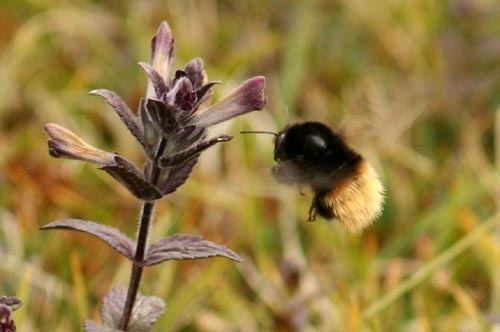 | ||
Similar Bombus hyperboreus, Bumblebee, Bombus alpinus, Bombus lapponicus, Bombus balteatus | ||
Bombus polaris is a common Arctic bumblebee species. B. polaris is one of two bumblebees that live above the Arctic Circle. The other is its social parasite Bombus hyperboreus. B. polaris is a social bee that can survive at near freezing temperatures. It has developed multiple adaptations to live in such cold temperatures. B. polaris has a thicker coat of hair than most bees, utilizes thermoregulation, and makes insulated nests.
Contents
- Taxonomy and phylogeny
- Appearance General
- Appearance Workers
- Thermoregulation
- Nests
- Nest structure
- Distribution and habitat
- Colony initiation
- Colony growth
- Foraging
- Colonies
- Workers
- Queens
- Males
- Diet
- Predators
- Parasites
- Human importance
- References
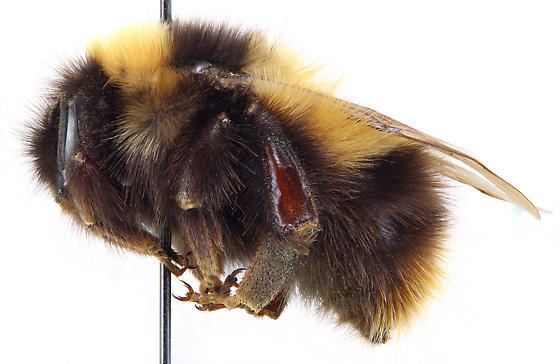
Taxonomy and phylogeny

Bombus polaris is part of the family Apidae, which is part of the larger class of Insecta. Apidae is the largest family of bees, consisting of the only species of bees used by humans for honey consumption. B. polaris is part of the subgenus Alpinobombus along with Bombus alpinus, Bombus balteatus, Bombus hyperboreus, and Bombus neoboreus. Alpinobombus bees occur in arctic and high alpine regions. It is of the Bombini tribe, which feeds on pollen or nectar.
Appearance (General)
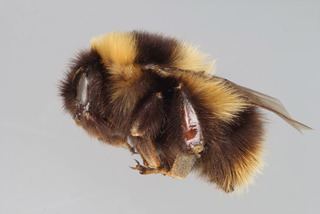
Bombus polaris has a thicker coat of hair than temperate bees in order to slow heat loss. Although the coloration of this bee is variable, the thorax is usually black with orange-yellow edges, while most of the abdomen is orange-yellow with a black tip. B. polaris also has a higher abdominal temperature than its temperate cousins.
Appearance (Workers)
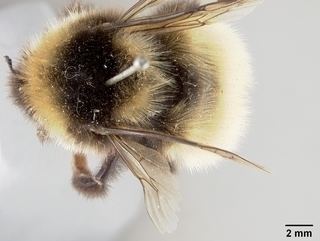
The variation in the color of the pubescence is noticeable variable. The pubescence of the apical dorsal abdominal segments varies from deep rust color to a dull yellow color. There is also a considerable variation in the size of the workers. Some can be scarcely 10 mm in length, while others can be much larger.
Thermoregulation

Additionally, B. polaris has a bio-mechanical method of bringing its body to a much higher abdominal temperature than its temperate relatives. The ability of B. polaris to fly in deep cold is due to a process called thermoregulation, which allows it to raise its internal body temperature to temperatures as high as 38 °C. For this reason B. polaris is likely to outcompete any temperate bumblebee species that might seek to expand to the northern range.
Nests
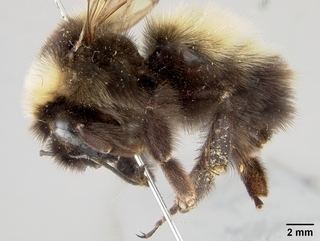
The nests are heavily insulated, which is an important factor in the bees’ energy conservation in the harsh polar environment. At the start of the colony cycle, the lone queen maintains a nest temperature of about 25-30 °C However, when she makes foraging trips at frequent intervals, the temperature of the nest will decline. At an air temperature of 10 °C, the nest temperature generally does not decline more than 7 °C in the half hour that the queen is foraging. After all of the sixteen to seventeen larvae of the first brood have developed into workers, the nest temperature is maintained at a steady 35 °C, and the comings and going of the queen and other foragers does not appear to affect the nest temperature. The nest of Bombus polaris also appears to have a higher nest temperature than those of honeybees and bumblebees from temperate climates.
Nest structure
First, a fertilized queen must locate a suitable nesting site. After this, she will build a cell to hold the food and provisions, and then a hatch camera to house her offspring. B. polaris queens will use a mixture of pollen and wax to build these initial structures. First the hatch camera will be constructed, followed shortly afterwards by the construction of a wax base. On top of this base, the queen will deposit a dust clump, which she will have covered in flower nectar. This will be ringed by a wax roller. She will then lay her eggs into the clump, pour them with a dust mixture, and then cover it with a wax membrane.
Distribution and habitat
This bumblebee has a wide circumpolar distribution, found in Canada, Arctic Alaska, Arctic islands (Devon Island, Ellesmere Island, Baffin Island and Greenland), northern Scandinavia and across Arctic Russia (Nenets, Yamalo-Nenets, Sakha and Chukotka). As of 2015, B. polaris is common and is not listed as endangered. Bombus polaris is an alpine species. They exclusively live at the summits of mountains. This clear separation between alpine species and subalpine species may be due to superior competition from the subalpine species, leading to a suboptimal habitat occupation of the alpine species. An alternative explanation is that the alpine bee species possess both the ability and body type to survive the colder temperatures, which naturally separates the two types of bees into distinct ecological territories. Alpine species usually have a larger body length in comparison to subalpine species.
Colony initiation
A Bombus polaris queens hibernate for about nine months, suspended in an almost lifeless state in a mouse nest or some other subterranean burrow. She will wait for the ground to warm. After this, B. polaris fertilized queens emerge from hibernation, visiting flowers and looking for areas to build potential nests. This signals the start of the seasonal cycle of development. Recently started colonies can be found in June or July.
Colony growth
B. polaris is a social bee that requires a completion of at least two generations every year. To make up for this short amount of time, the queens produce many workers per generation. The initial brood is a clutch of around twenty larvae that emerge in about ten days. Arctic bumblebee larvae grow fast, and will experience a near tropical environment due to the heat production of their queen, and later on, of the workers.
Arctic bumblebees have a larger initial brood as an adaptation to speed up the colony cycle in the very short growing season. Since the queen has time to produce only a few broods, she must also lay very large egg clutches. The life cycle is sped up by incubating the eggs internally that are already in the abdomen, thus increasing the rate of egg production and egg growth.
Foraging
Bombus polaris is one of the few bumblebee species where the queen will continue to forage while some workers have already emerged in the nest. She divides her time between incubating her brood and regulating the temperature of the nest to leaving the nest to forage. The food reserves gathered in the day are generally sufficient for only one night. When the bees exhaust their food, they enter torpor and cease to incubate. Occasional periods of semi-starvation lasting for a day or two do not harm the colony. The bees simply become drowsy and remain in a state of suspended animation.
Colonies
The colony begins in the summer in June. The colony is only able to survive for two or three months until winter hits again. All workers, drones, and most females die with the colony.
Workers
The queen’s first brood after the start of the colony will develop into worker bees – small sterile females who will enlarge the nest, forage, and tend to the next generation of bees. Worker bees will die along with the colony at the beginning of winter.
Queens
The queen is the sole survivor of her colony after 9 months of hibernation during the winter. In the Arctic, only one queen per colony on average will survive the winter to renew the next life cycle. The colony only has one or two months to complete the social cycle of two generations. The old queen dies with her progeny.
Males
The queen’s second brood in late summer include male drones and fertile females who are candidates for next year’s queen. The drone’s sole function is to fertilize the females, but most females will die along with the drones at the beginning of winter.
Diet
Large zygomorphic flowers of Pedicularis are dependent on B. polaris. B. polaris works the spikes of Pedicularis upwards from the bottom. Through this behavior, the adaption of gustatory organs to sugar is offset by the increasing concentration of sugars in the nectar up the spike. This behavior is also significantly related to pollination.
Predators
Predators of Bombus polaris include the Buff-breasted sandpiper (Tryngites subruficollis), common eider (Somateria mollissima), and old squaw (Clangula hyemalis), which will either eat the bees or feed them to their young.
Parasites
Bombus hyperboreus habitually takes over the nests of Bombus polaris. Because of the short Arctic summer, B. polaris normally has time to produce only one brood of workers before the colony has to raise queens. When B. hyperboreus takes over the nest, all of her young are raised as queens by the B. polaris workers. Thus, B. hyperboreus workers are not produced and pollen collectors are never seen.
Human importance
Due to its cold tolerance the Bombus polaris appears to be one of the earliest pollinators of vegetation in the Arctic each year. Some plants they pollinate include Arctic poppies, Arctic roses, and Arctic willows. Their pollinator effect seems to be heaviest in the early spring, but decreases as the year continues. Samuel Robinson has found that, by the time most scientists arrive for the brief warm summers, the "Bumblebees (Bombus spp.) and Butterflies and Moths (Lepidoptera) were found to play a minor role in pollination, while flies (Dipterans) were shown to be the major pollinators." One of the leading modern experts on B. polaris, Bernd Heinrich, agrees with this finding, saying that when "it gets warm, there’s a lot more fly pollination, and there’s actually some pollination by mosquitoes, as well."
